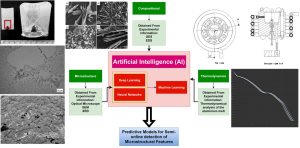Cool Vibes
This project is for the characterization of high purity (5N-5N5-6N) Aluminum and Copper to be used in the manufacture of vibration damping high efficiency heat conductors to be utilized at extremely low temperatures.
Corrosion and Stress Corrosion Cracking Research
The field of corrosion and stress corrosion cracking (SCC) studies is critical for advancing the reliability and longevity of metals and alloys across various industries, particularly in sectors such as energy, transportation, and aerospace. At our university, the research in this area is focused on understanding and mitigating the complex mechanisms of corrosion and SCC in metals, with a strong emphasis on novel materials and manufacturing methods, including additive manufacturing (AM). These studies are essential for predicting material behavior in harsh environments, thus ensuring structural integrity and safety.
A distinctive feature of our research is the innovative application of micro electrochemical cells to investigate corrosion processes at the microscale. This cutting-edge technique allows for highly localized measurements of electrochemical activity, providing unprecedented insights into the heterogeneous nature of corrosion in complex alloys and materials produced by additive manufacturing. Micro electrochemical cells enable the precise mapping of corrosion initiation sites and the study of localized corrosion phenomena, which are often the precursors to stress corrosion cracking.
Furthermore, our research delves into the SCC mechanisms of additively manufactured metals and alloys, where unique microstructures and residual stresses are introduced during the manufacturing process. By systematically exploring these characteristics, we aim to elucidate how they contribute to SCC susceptibility and develop strategies to enhance material performance. Through a combination of experimental approaches, advanced characterization techniques, and modeling, we seek to bridge the gap between fundamental understanding and practical application, ultimately contributing to the development of more durable, corrosion-resistant materials.
Our corrosion and SCC research not only addresses traditional material challenges but also supports the growing need for robust, high-performance materials in emerging technologies, making our contributions vital to both academic advancement and industrial innovation.
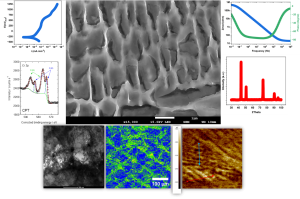
Electrically assisted heat treatment and deformation of Metals
The use of electric current, including high-intensity pulses, has been shown to influence deformation mechanisms, recrystallization processes, and phase transformations in various metallic alloys. Reductions in transformation temperatures, accelerated precipitation and solubilization kinetics, increased nucleation rates leading to finer grain sizes, and enhanced material formability are key phenomena observed when comparing conventional thermomechanical treatments with those assisted by electric current. The goal of this research is to demonstrate the presence of effects beyond mere Joule heating and to assess the potential for improving energy efficiency and enhancing product performance with treatments or deformations assisted by electric current.
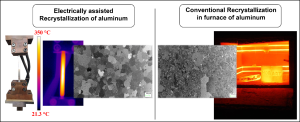
Engineering Duplex Stainless Steels: Unveiling the Role of Manufacturing in Corrosion Resistance and Mechanical Properties
Duplex stainless steels, introduced commercially in the early 20th century, offer an exceptional combination of corrosion resistance and mechanical strength. Investigating the corrosion and embrittlement mechanisms in these modern alloys presents a valuable opportunity to explore the relationships between their complex metallurgical conditions—shaped by various manufacturing processes—and their distinctive properties. This research focuses on examining the interplay between production techniques, microstructure, and material properties, including processes such as annealing, forging, and welding across various duplex stainless steel alloys. The precipitation of secondary phases through their interaction with dislocation movement, the depletion of elements from the matrix, and the consequent creation of sensitized zones are key factors in the deterioration of these alloys’ mechanical and corrosion properties. Gaining a deeper understanding of these mechanisms and evaluating their impact is essential for optimizing processes to enhance performance.

Hybrid nanocomposites as anticorrosive additives in waterborne paints
The project aims to design, synthesize, and characterize hybrid nanocomposites that combine a custom-made organic polymer with an inorganic metal-based component (zinc phosphate or zinc oxide), known for their anticorrosive properties. These nanocomposites are incorporated into various waterborne paints, followed by a thorough assessment of their homogeneity, adhesion, and anticorrosive performance.
study of precipitation of secondary phases in UNS S 32760 produced by casting
This project focuses on understanding and controlling the formation of secondary phases in super duplex stainless steel (SDSS). Stainless steels are remarkable materials widely used in applications ranging from construction and transportation to healthcare and energy production. Super duplex stainless steel, particularly UNS S 32760, is commonly used in offshore plants for valves and pipes due to its excellent corrosion resistance and high strength. However, instability in the ferritic phase can lead to the formation of secondary phases, which negatively affect the mechanical and electrochemical properties of SDSS. This research aims to minimize or control the formation of these detrimental phases, thereby preserving the material’s advantageous properties and ensuring optimal performance in critical applications.
Characterization : SEM-BSD with EDS has been used to observe different phases. These phases have been quantified by image j software.

Materials for non-lubricating fluid in plain bearing applications
Friction is a major contributor to energy losses across numerous technological fields, from automotive to industrial mechanics, with the associated economic costs estimated to account for 2-7% of GDP in various countries. This research project investigates wear and corrosion phenomena under extreme mechanical conditions in shaft-plain bearing systems, focusing on high loads, high RPMs, and scenarios with minimal or no lubrication. Utilizing a custom tribometer, the study explores innovative material pairings aimed at extending the lifespan of mechanical components and reducing friction.
The project specifically emphasizes the development and evaluation of thermal-sprayed coatings and nickel-phosphorus (NiP) plating on various metallic substrates. Research activities include the structural and compositional characterization of these coatings, along with tribological testing to assess their performance under demanding conditions. Additionally, the corrosion-resistant properties of these innovative materials are analyzed to understand and mitigate tribocorrosion effects, further enhancing the durability of mechanical parts.

This PhD project, conducted in collaboration with the National Institute of Nuclear Physics at the National Laboratory of Legnaro, is part of the LARAMED project, which aims to produce innovative radiopharmaceuticals (such as 155Tb and 67Cu) for nuclear medicine using cyclotron technology. Radiopharmaceuticals consist of a radioisotope (an unstable atom that emits energy), a chelator that encapsulates the radioisotope, and a linker that attaches to the targeting agent. Depending on the nuclear properties of the radionuclide, radiopharmaceuticals can be used for diagnostic imaging (SPECT or PET) as well as for therapeutic applications.
In this context, radioisotopes are primarily produced by irradiating a specific target material with a cyclotron. These targets are composed of both the material to be irradiated and a support material and must meet stringent standards. However, a key challenge in this field is developing reliable techniques for producing solid targets. This project focuses on advancing an innovative target production method known as Spark Plasma Sintering (SPS), a promising approach to address current limitations in target preparation for radiopharmaceutical production.
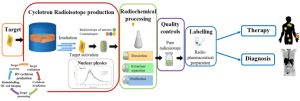
Development of High-Performance Semiconductor Thin Films for Solar Cell and Energy Storage Applications
This project focuses on the processing and performance evaluation of electrodeposited chalcogenide thin films, specifically SnS, SnSe, and CZTSe, for applications in both solar cells and pseudocapacitors. These materials, known for their favorable optical and electronic properties, are synthesized via electrodeposition, providing a scalable and cost-effective route. For solar cell applications, the performance of the films is assessed using IV (current-voltage) curves to measure power conversion efficiency and EQE (external quantum efficiency) curves to evaluate their response to different wavelengths of light. For pseudocapacitive applications, the electrochemical properties of the thin films are investigated through techniques such as Cyclic Voltammetry (CV), Potentiodynamic polarization, Electrochemical Impedance Spectroscopy (EIS), and Galvanostatic Charge-Discharge (GCD). These methods allow for the analysis of charge storage capacity, energy density, and stability under cyclic loading conditions.
To ensure high quality and optimal performance, a thorough characterization process is conducted. X-ray Diffraction (XRD) is used to determine the crystal structure and phase composition, while Raman spectroscopy provides insights into vibrational modes and material purity. Scanning Electron Microscopy (SEM) and Energy Dispersive Spectroscopy (EDS) are employed to examine surface morphology and elemental composition, ensuring uniformity and stoichiometry. Optical analysis techniques are utilized to assess the bandgap and light absorption properties of the thin films, which are crucial for solar cell efficiency. Through this integrated approach, the project aims to develop highly efficient, stable, and environmentally friendly thin-film materials for next-generation solar cells and energy storage devices.
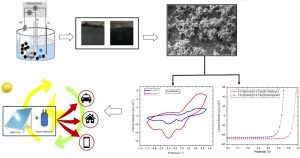
Study of Sustainable Treatments for the Removal of Organic Contaminants from Metallurgical Residues
This project focuses on the recovery of mill scale from the steelmaking industry using eco-friendly and innovative thermal and chemical techniques.
Pyrometallurgical Recovery of Metallic Waste Using Microwaves
This research project concerns microwave (MW) assisted pyrometallurgical processes to recover metals from different types of metallic wastes. In particular, the sustainable recovery of critical raw materials from discarded Li-ion batteries is currently being explored. MW treatment parameters are being investigated to perform effective carbothermal reduction of the cathode materials, followed by recovery of Co and Li through innovative techniques avoiding the use of aggressive chemicals.
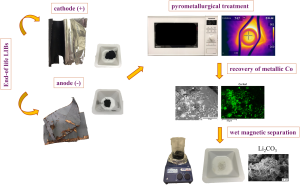
Precipitation of Secondary Phases and Corrosion Properties of Duplex Stainless Steels Post-Hot Forging
This project examines the formation of secondary phases and the resulting corrosion behavior in duplex stainless steels following hot forging.
Implementing Machine Learning for Sustainable Improvement in Aluminum Alloys Production: A Pathway to Efficiency, Quality, and Environmental Responsibility
Industries prioritize sustainability by minimizing energy use and carbon emissions. Aluminum production relies on energy-intensive primary aluminum from bauxite, facing strict regulations. Secondary aluminum is an alternative, reducing energy use and carbon emissions by up to 70%. Impurities like iron hinder its use because they form harmful intermetallic compounds that impair casting quality. Scrap material poses challenges, especially iron, affecting mechanical properties. These compounds vary in morphology and concentration, influenced by casting conditions and alloying elements, and tend to accumulate, leading to cracks in cast products. For these reasons, early assessment of such impurities during melt preparation is crucial.
Traditional analysis methods are time-intensive and lack detailed insights. Rapid chemical tests fail, requiring microstructural analysis via SEM, which is resource-intensive. Actually, no solution exists for obtaining this melt quality information in quasi-real time to input into the model. Thermodynamic events during aluminum alloy solidification offer real-time insights into phase presence and impurities. Thanks to the thermal analysis systems it is possible to obtain data related to the events, which are affected by the impurities, that occurs during the solidification. For this, it is necessary to develop advanced machine learning (ML) and deep learning (DL) algorithms and to implement them in the analysis of the solidification curves of secondary aluminum alloys in order to realize an accurate system able to detect the harmful impurities in real time and to improve the quality of the aluminum production and casting processes
